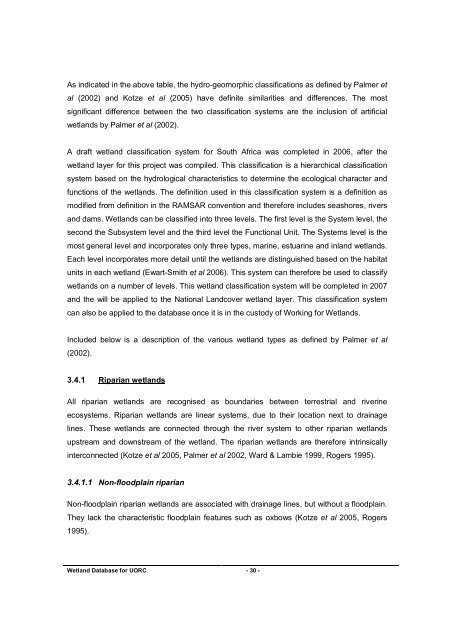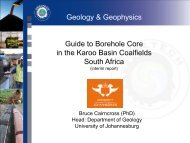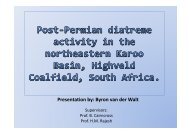coaltech upper olifants river catchment wetland inventory ...
coaltech upper olifants river catchment wetland inventory ...
coaltech upper olifants river catchment wetland inventory ...
You also want an ePaper? Increase the reach of your titles
YUMPU automatically turns print PDFs into web optimized ePapers that Google loves.
As indicated in the above table, the hydro-geomorphic classifications as defined by Palmer et<br />
al (2002) and Kotze et al (2005) have definite similarities and differences. The most<br />
significant difference between the two classification systems are the inclusion of artificial<br />
<strong>wetland</strong>s by Palmer et al (2002).<br />
A draft <strong>wetland</strong> classification system for South Africa was completed in 2006, after the<br />
<strong>wetland</strong> layer for this project was compiled. This classification is a hierarchical classification<br />
system based on the hydrological characteristics to determine the ecological character and<br />
functions of the <strong>wetland</strong>s. The definition used in this classification system is a definition as<br />
modified from definition in the RAMSAR convention and therefore includes seashores, <strong>river</strong>s<br />
and dams. Wetlands can be classified into three levels. The first level is the System level, the<br />
second the Subsystem level and the third level the Functional Unit. The Systems level is the<br />
most general level and incorporates only three types, marine, estuarine and inland <strong>wetland</strong>s.<br />
Each level incorporates more detail until the <strong>wetland</strong>s are distinguished based on the habitat<br />
units in each <strong>wetland</strong> (Ewart-Smith et al 2006). This system can therefore be used to classify<br />
<strong>wetland</strong>s on a number of levels. This <strong>wetland</strong> classification system will be completed in 2007<br />
and the will be applied to the National Landcover <strong>wetland</strong> layer. This classification system<br />
can also be applied to the database once it is in the custody of Working for Wetlands.<br />
Included below is a description of the various <strong>wetland</strong> types as defined by Palmer et al<br />
(2002).<br />
3.4.1 Riparian <strong>wetland</strong>s<br />
All riparian <strong>wetland</strong>s are recognised as boundaries between terrestrial and <strong>river</strong>ine<br />
ecosystems. Riparian <strong>wetland</strong>s are linear systems, due to their location next to drainage<br />
lines. These <strong>wetland</strong>s are connected through the <strong>river</strong> system to other riparian <strong>wetland</strong>s<br />
upstream and downstream of the <strong>wetland</strong>. The riparian <strong>wetland</strong>s are therefore intrinsically<br />
interconnected (Kotze et al 2005, Palmer et al 2002, Ward & Lambie 1999, Rogers 1995).<br />
3.4.1.1 Non-floodplain riparian<br />
Non-floodplain riparian <strong>wetland</strong>s are associated with drainage lines, but without a floodplain.<br />
They lack the characteristic floodplain features such as oxbows (Kotze et al 2005, Rogers<br />
1995).<br />
Wetland Database for UORC - 30 -




